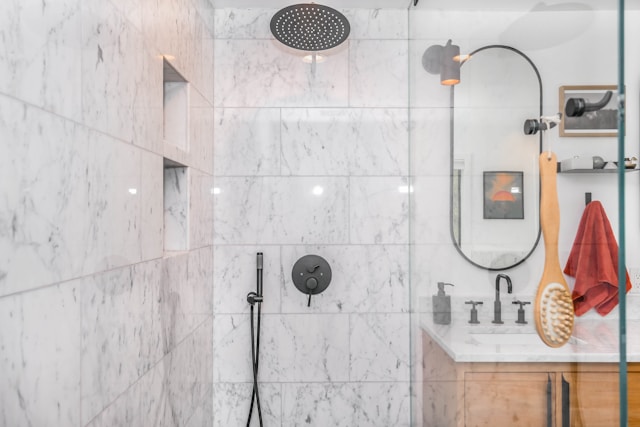Water damage is one of the most frustrating issues you can face in your bathroom, especially if it’s caused by a shower base crack. Ignoring a cracked shower base can lead to severe water damage, mold growth and costly repairs. Here’s a simple guide on how to handle water damage from a cracked shower base.
Identifying the Problem
First, it’s essential to recognize the signs of a cracked shower base. You might notice water pooling around your shower, a damp smell, or visible cracks and chips. If you spot any of these, it’s essential to act quickly to prevent further damage.
Immediate Steps to Take
1. Stop Using the Shower
As soon as you notice the crack, stop using the shower to prevent more water from leaking. This can help minimize the extent of the water damage.
2. Dry the Area
Use towels or a wet vacuum to dry the water around the shower. This step is vital to prevent mold growth, which can start within 24-48 hours of water exposure.
 3. Inspect the Damage
3. Inspect the Damage
Carefully inspect the cracked area to determine the extent of the damage. Look for signs of water seeping into the flooring or walls. If the crack is large or the water damage extensive, you might need professional help.
Repairing the Shower Base
1. Clean the Shower Base
Before you start the repair, clean the shower base thoroughly. Remove any soap scum, dirt, or debris that could interfere with the repair process.
2. Repair the Crack
For minor cracks, you can use a shower base repair kit. These kits typically include epoxy or resin that you can apply to seal the crack. Follow the instructions on the kit for the best results. Here’s a basic outline of the process:
- Mix the epoxy or resin according to the instructions.
- Apply the mixture to the crack using a putty knife or applicator.
- Smooth out the epoxy to ensure it fills the crack completely.
- Allow the repair to cure for the recommended time.
3. Replace the Shower Base (If Necessary)
If the crack is too severe for a simple repair, you might need to replace the entire shower base. This is a more involved process and might require professional help. Removing the old shower base and installing a new one can ensure a watertight seal and prevent future leaks.
Handling Water Damage
1. Assess the Water Damage
Once you’ve addressed the shower base crack, focus on the water damage. Inspect the surrounding areas, including walls and flooring, for signs of water damage. Look for discoloration, warping, or mold growth.
2. Dry Out the Area
Use fans, dehumidifiers, and open windows to dry out the area thoroughly. Removing moisture is crucial to prevent mold and further damage.
3. Repair Damaged Areas
Depending on the extent of the water damage, you may need to repair or replace damaged materials. This could include replacing drywall, flooring, or even structural elements if the damage is severe. In some cases, you might need professional help to ensure the repairs are done correctly and safely.
Preventing Future Issues
1. Regular Maintenance
Regularly inspect your shower base for signs of wear and tear. Address any small cracks or chips immediately to prevent them from becoming larger problems.
2. Proper Installation
Ensure your shower base is installed correctly. Poor installation can lead to stress points that might crack over time. If you’re installing a new shower base, consider hiring a professional to ensure it’s done right.
3. Use Quality Materials
Invest in a high-quality shower base that’s less likely to crack. While it might be more expensive upfront, it can save you money on repairs in the long run.
Facts and Statistics
- According to the Environmental Protection Agency (EPA), mold can start growing within 24-48 hours after water exposure.
- Water damage claims are one of the most common home insurance claims, with the Insurance Information Institute reporting that water damage accounts for nearly 29% of all homeowner claims.
- Regular maintenance and timely repairs can reduce the risk of severe water damage by up to 80%.
FAQ
Q: How can I tell if my shower base is cracked?
A: Look for visible cracks, water pooling around the shower, or a damp smell in the bathroom.
Q: Can I repair a cracked shower base myself?
A: Yes, for minor cracks, you can use a shower base repair kit. For severe cracks, it’s best to hire a professional.
Q: How quickly should I address a cracked shower base?
A: Immediately. The longer you wait, the more extensive the water damage can become.
Q: What should I do if there’s mold after water damage?
A: Mold can pose serious health risks. It’s best to contact a professional mold remediation service to handle it safely.
Q: How can I prevent my shower base from cracking in the future?
A: Regularly inspect your shower base, ensure proper installation and use high-quality materials.
Handling water damage from a cracked shower base promptly can save you from extensive repairs and potential health hazards. By following these steps, you can repair the damage and prevent future issues, ensuring your bathroom remains a safe and pleasant space.









